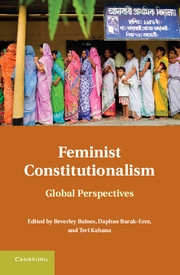Book contents
- Frontmatter
- Contents
- Foreword
- Contributors
- Introduction
- Part I Feminism as a Challenge to Constitutional Theory
- Part II Feminism and Judging
- Part III Feminism, Democracy, and Political Participation
- Part IV The Constitutionalism of Reproductive Rights
- Part V Women's Rights, Multiculturalism, and Diversity
- 17 Constitutional Rights of Women under Customary Law in Southern Africa
- 18 Minority Women
- 19 Watch GRACE Grow
- 20 Critical Multiculturalism
- 21 Democratic Theory, Feminist Theory, and Constitutionalism
- Part VI Women between Secularism and Religion
- Index
- References
19 - Watch GRACE Grow
South African Customary Law and Constitutional Law in the Equality Garden
Published online by Cambridge University Press: 05 June 2012
- Frontmatter
- Contents
- Foreword
- Contributors
- Introduction
- Part I Feminism as a Challenge to Constitutional Theory
- Part II Feminism and Judging
- Part III Feminism, Democracy, and Political Participation
- Part IV The Constitutionalism of Reproductive Rights
- Part V Women's Rights, Multiculturalism, and Diversity
- 17 Constitutional Rights of Women under Customary Law in Southern Africa
- 18 Minority Women
- 19 Watch GRACE Grow
- 20 Critical Multiculturalism
- 21 Democratic Theory, Feminist Theory, and Constitutionalism
- Part VI Women between Secularism and Religion
- Index
- References
Summary
The reputed reference to constitutions as “living trees” suggests that constitutional provisions grow and evolve in accordance with changing social, political, and legal contexts. As a living tree, a constitution is rooted in a nation's history and culture; it shapes the nation's future and influences the interaction of its citizens in the present. As the tree blossoms, it provides shade for those who seek refuge under the umbrella of constitutional protection. Constitutional jurisprudence is the fruit of careful judicial pruning and fertilizing of constitutional rights.
South Africa's 1996 Constitution is heralded as one of the world's most progressive, and it is no exception to the living tree metaphor. Judicial interpretation and application of the Bill of Rights in South Africa's Constitution involves drawing from the deep roots of culture to harvest the fruit of a new country nourished by hope and sustained by the promise of equality. The living tree metaphor can be expanded to apply to African customary law as it also grows and develops with changing social context.
This chapter considers the living trees of the South African Constitution and customary law, as they exist in what is constructed herein as the Garden of Equality. The quest for equality is at the heart of the Constitution, and specific provision is made in Section 9 of the Constitution’s Bill of Rights. The metaphor of living trees in the Garden of Equality includes yet a third three. This third tree represents the common law: the legislation and case law that govern the lives and interactions of South African citizens who are not otherwise governed by customary law. The Constitution provides that any discord between customary law and common law notions of equality be resolved by deference to the provisions and principles contained in the Constitution.
- Type
- Chapter
- Information
- Feminist ConstitutionalismGlobal Perspectives, pp. 357 - 376Publisher: Cambridge University PressPrint publication year: 2012

